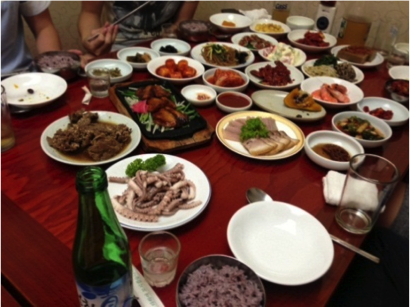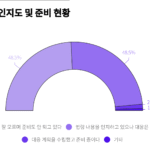The team that eats together, succeeds together.
이것만은 기억하자. 스타트업을 운영하는 사람이라면 포브스, 테크크런치, 넥스트 웹 등등의 잡지에 기고 된 적이 있을 ‘성공한 창업자의 10가지 조언’ 또는 ‘창업자들이 성공하기 위해 찾아봐야 할 10가지 블로그’ 같은 많은 글들이 영혼없이 전해지는 것을 보았던 적이 있을 것이다. 그리고 보통 그런 글들은 꼬리에 꼬리를 물고 이야기 되는 비슷한 이야기들 같다는 것이 본인의 생각이다. 어떤 창업자는 이렇게 했고, 또 다른 창업자는 다른 방식으로 했다는 설명들 뿐이고, 늘 그러하듯이, 마지막은 창업자는 스스로 맞는 길을 찾아야 한다고 마무리 되는 것이 보통이다.
젠장! 왜 이런 비슷하면서도 의미없는 글들을 읽으면서 시간을 낭비해야 하는 걸까?
그렇지만, 내가 오늘 공유하고자 하는 하나의 경험은 그 반대가 실패임이 분명한 것이다. ‘스타트업 팀원들과 함께 식사를 하는 것, 그리고 가능하면 자주 많이 할 것’이 내가 공유하고자 하는 것이다. 로켓을 발사하기 위한 과학 기술도 아니고 핵물리학도 아닌, 너무도 간단한 진화 사회학이다. 한정식(내가 제일 좋아하는 것)이라고 해도 되고, 식사를 공유하는 것이라고 해도 되고, 빵을 나누는 것이라고 해도 되고 당신이 원하는 어떠한 방식으로 불러도 될 것이다. 인류학의 기록에서도 고대부터 지금까지 식사를 함께하는 것은 의식적인 것일 수도 있고, 정신적 교감을 하는 것일 수도 있으며, 커뮤니티의 유대감을 강화하는 일부분 일 수도 있다고 보고 있다.
“식사를 함께하고 공유하는 것은 육체에 에너지를 주입하는 기계적인 과정에서 가족과 커뮤니티의 의식과 같은 일인 것이고, 단순한 생물학적인 행위에서 문화적인 움직임으로 승격이다.” -Michael Pollan, In Defense of Food: An Eater’s Manifesto
식사를 함께 하는 팀은 신체적 에너지를 채우는 것 이상을 한다고 할 수 있다. 유대감은 강화되고, 경험은 공유되고, 서로를 이해 할 수 있는 기회가 되며, 문제나 도전적인 사항들에 관해 얘기를 함으로써 팀원들은 해결책을 만들어 나갈 수 있는 것이다.
거의 모든 창업자들은 ‘문화’를 어떻게 만들어가야 할지 고민한다. 우리 팀의 문화는 어떤 것이어야 할까? 어떻게 팀문화를 발전시킬 수 있을까? 새로운 멤버들에게 어떻게 하면 기존의 문화를 전해줄 수 있을까? 내가 해줄 수 있는 대답은 지난 경험들과 역사에서 배워보라는 것이다. 한 나라의 왕, 왕국의 사신단, 종교 지도자들, 장군들, 선교자들 그리고 정복자들에게서 배워볼 수도 있다는 것이다. 그들의 이야기가 공통적으로 전해주는 메시지는 ‘식사를 함께해라, 그러면 너의 문화는 스스로 번창하고 전해진다.’라는 것이다.
창업을 하는 것은 생각만큼 쉬운 일이 아니며 꾀 부담스러운 일이 될 수도 있다. 모든 결정에는 불확실성이라는 위험요소가 있고, 사업 비용이라는 현실적인 문제도 있으며, 스트레스를 주는 여타 다른 일상적인 문제들도 있을 것이다. 스트레스 요인을 떠나서, 시간의 흐르면서 창업자가 가지고 있는 비젼은 어느 새 아집에 빠져있을 수도 있다. 제품을 만들고 그것을 시장에 내놓기 위한 의지와 동기는 스스로를 아집에 빠져들게 할 수도 있고, 다음 과정 과정마다 편협한 선택을 하게 만들 도 있으며, 결과적으로는 넓게 바라볼 수 있는 비젼을 잃게 될 수도 있게 되는 것이다.
식사를 함께 하는 것은 키보드 소리만 들리는 답답하고 조용한 사무실에서 정신적, 육체적으로 벗어나서 함께 일하는 팀원들과 전혀 다른 차원의 소통을 하는 것이라고 생각한다. 본인이 추구하고 있는 가치와 비젼을 공유할 수 있는 기회임과 동시에 다른 팀원들의 동기, 문제점, 의견 등을 들어 볼 수 있는 기회도 되는 것이다. 단순히 UI/UX같은 것들을 논하는 것은 아니라는 것이다.
더 깊이 들어가기 전에 먼저 고백하자면, 1년 전만 하더라도 식사를 함께 하는 것이 창업자들이 할 수 있는 팀빌딩 노력에서 제일 중요한 것이라고 말하지 않았을 것이다. 대학때 스포츠 댄스 팀원들이 연습을 마치고 함께 차를 마시거나, 다같이 모여서 한 학기에 두번씩 저녁 모임을 하기도 하였고, 함께 일했던 대학생활 팀원들도 팀디너 같은 모임으로도 유명했었다. 그럼에도 불구하고 나는 함께 식사하는 것의 중요성을 간과했었다.
여전히, 우리 easi6팀이 모여지기 전에는 그 중요성을 느끼지 못했다. 아마도, 창업 멤버로서 팀빌딩에 참여한 것이 그 중요성을 알게 된 계기일 것이다. 반면에, 스포츠 댄스팀에서나, 대학생활 팀에서의 팀디너는 의무적 성향이 강하기도 했고, 전통을 이어간다는 의미가 강하기도 했다. 그렇지만, 우리 easi6에서는 아직 전통이란 것이 존재하지 않았다. 그렇지만 그 문화라는 것은 우리 easi6를 다른 이들에게 설명하는 과정에서 드러나고 있었다. 우리의 행위는 필요에 기반을 두고 있었고, 모든 결정은 이성에 기반을 두고 있었다.
그래서, 만약에 질문을 받는 다면, 한국 독자분들이 좋아할 만한 무언가가 있다고 말할 수 있다. 여행 저널에 나오는 그런 느낌의 글이 아니라, 미국을 한번도 떠나보지 않았던 미국인으로서 깊은 의미를 전하고자 한다. 그것은 한국의 독특한 식문화에서 오는 것인데, 자세히 말하자면 나눠 먹는 한국의 식문화 경험에서 나오는 것이라고 할 수 있다.
서양의 문화를 폄하하고자 하는 것은 아니지만, 서양에서 ‘let’s share a meal’은 각자의 접시위에 있는 음식을 먹으면서 대화를 하고 지적 교류를 하자는 것이 그 의미이다. 이쪽 저쪽의 접시에 포크를 가져간다는 것은 환영의 대상이기 보다는 방해되고 매너없는 행위가 되는 것이다. 직접적으로 의사를 전하고 나서야, 진짜 나눠먹기가 가능한 문화인 것이다. 미리 물어보는 것이 보통이라는 것이다. 그렇지만 한국의 식사예절은 사뭇 다르다. 특히 음주문화의 경우도 더 그렇고, 식당에서 내가 앉기도 전에 물이 가득 차여진 컵이 나의 동료로부터 전해져온다. 앉기 시작하면서 상대에 대한 배려를 시작으로 식문화가 전해진다. (한국 동료들과 술이라도 마시러 간다 치면 말할 것도 없다. 당신의 술잔이 비어 있는 시간은 단 1분도 되지 않을 것이다.)
이 사진에서 우리 식사는 그냥 테이블에 둘러 앉는 것으로 시작한다. 그 다음, 여러 반찬을 먹기 시작하는데, 각 개인의 음식이 아닌 공유를 위한 음식들이다. 개인 접시가 아닌, 테이블 한 가운데에 놓여 있으며 모두가 함께 먹을 수 있는 것이다. 흥미 있는 것은 한국의 전통 식사인 한정식은 외국의 개인 접시의 개념과 달리 여러 반찬들로 구성이 되어 있는 것이다.
그렇지만 모든 한국 음식이 한정식의 형태로 나오지는 않는다. 사실 한정식은 특별한 일이 있을 때 먹는 음식으로 알고 있다. 그렇지만 그것과는 상관없이 나눠 먹는 것은 이 식문화의 기본이다. 서양인으로서 식당에 들어가서 자리에 앉으면 접시를 고르고 내가 혼자 먹을 것이라고 생각한 했던 것과 그 고른 접시들이 나눠 먹어야 하는 반찬들이라는 것을 나중에 알게 된 적이 샐 수 없을 정도로 많다. 개인 적으로 먹도록 주어진 음식이라고 할지라도, 다른 친구들 처럼 젓가락을 이리저리 움직이면서 결국은 나눠먹고 교환해 먹도록 되는 문화인 것이다.
도대체 내가 말하고자하는 요점이 무엇인가?라구 묻고 싶을 것이다. 요점은 나눠 먹는 한국의 식문화는 많은 이점이 있다는 것이다. 단순히 에너지를 채우는 것이 아니라 팀원들을 위해서 삼겹살을 굽고 자르고 상대의 막걸리 잔을 가득채워 주는 것은 그 함께라는 의미 이상의 행위인 것이다. 그리고 이런 실제적인 행위들은 능동적인 나눔인 것이고 식사를 함께할 수록 계속적으로 이어지고 강화되어서 문화가 된다고 생각한다.
흔히들 말한다. 당신이 먹는 것이 당신을 말해준다라고. 이것에 다음의 문장을 더하고 싶다. ‘당신이 먹는 방식이 당신을 말해준다’ 당신의 팀원들과 함께 먹어라. 장담하건데, 스타트업에서는 많은 것을 바뀌게 만들것이다.
조던 J.자레키 / Growth Operations of easi6
영어 원문
Remember this. As a startup entrepreneur, you are bombarded daily with some piece of half-hearted advice, some article published by Forbes, TechCrunch, The Next Web, etc., on the top ‘10 Quotes from Successful Entrepreneurs,’ or ‘10 Blogs Every Entrepreneur Should Follow’. And, it always seems that the quotes chase themselves in circles, and that the blogs do little but pick at one another. One entrepreneur did it this way, and the other did it that way. And, of course, then there’s the most painful article explaining how each entrepreneur must find his own way.
F**k! Why do I waste my time reading these things in the first place?
However, this is one piece of advice that I will guarantee you has only unsuccessful opposition: Eat together with your startup team. And, do it as often as possible. It’s not rocket science or nuclear physics; it’s simple, evolutionary sociobiology. Call it what you may (sharing a meal, breaking bread, communion, a Seder, a potluck, Koinonia, Hanjeongsik – my favorite~^^), the anthropological record from ancient times until our present day is littered with accounts of ritual meals, shared in the spirit of instilling and reinforcing a sense of community.
“The shared meal elevates eating from a mechanical process of fueling the body to a ritual of family and community, from the mere animal biology to an act of culture.”
-Michael Pollan, In Defense of Food: An Eater’s Manifesto
The team that eats together does more than recharge the batteries. The team bonds, shares an experience, fosters mutual understanding, reflects concurrently, addresses challenges, and collectively formulates solutions.
Every startup entrepreneur struggles with the concept of ‘culture.’ What should be our team culture? How do we foster a team culture? How do we pass it on to our new members? My advice: Learn from the historical masters. Learn from the kings, royal envoys, religious leaders, missionaries, generals, and conquistadores. Eat together, and your culture will manifest itself.
Building a startup, day-in and day-out, can become overwhelming at times. There is always the spectre of uncertainty lurking behind every decision, always the weight of mounting business expenses, always the stressors of daily life. And, aside from the stressors, the mere passage of time can place blinders on your vision. In your drive to bring a product to market and grow your business, it is easy to accept the blinders, to stay narrowly fixed on the next step, and to completely lose sight of the horizon – avoiding ant hills while forging a mountain.
Sharing a meal with the team is an opportunity to step out of that stuffy, cramped, often awkwardly-silent startup office, enjoy a mental and physical reprieve, and connect with your fellow startup ninjas at an entirely different level – both professional and personal. It’s an opportunity to share your values and vision, as well as to listen to your team, hear their motivations, and discuss their concerns – in life, not just on the new UI/UX.
However, before I go any further, I must make a confession. As anthropologically universal as the concept of sharing a meal is, a year ago, I would never had told you that eating with your team was one of the single most important team-building activities that a startup founder can do. Sure, my ballroom dance team back in college had a post-practice ritual of sprinting to the local teahouse (bubble tea that is). And, no doubt, the ballroom team hosted potluck dinners at least twice a semester, in addition to the annual picnic. For that matter, our crew at Late Nite Binghamton was well-known for its staff dinners and weekend trips too.
Still, it was not until the easi6 came together that it all hit home for me. Maybe this was because all of easi6’s activities had to be initiated by the co-founding team, myself included. Conversely, the ballroom potlucks and the Late Nite dinners were by mandate of my superiors and were in-keeping with years of tradition. But, at easi6, tradition did not exist. Culture was but that shadowy term that crept up behind us and stood over us while we were explaining our startup to non-easi6ers. Actions were inspired by some need, and rational went into every decision.
So, if you ask me, there was something else here which our Korean readers are likely to appreciate. Now, I don’t mean for this piece to take on the tone of a travel journal because, for sure, I could have relayed to you as deep a revelation without ever having stepped foot outside of the United States. But, what I mean to get at is the uniqueness of a Korean meal. More specifically, I mean to draw your attention to the inherently-altruistic and socially-conscious experience of sharing a Korean dinner.
A word of caution: I do not mean to deride Western culture. All the same, when we (Westerners) say, ‘let’s share a meal’, it’s more of an intellectual sharing – a sharing of conversation around a dinner table, each plate belonging to its spatially-nearest consumer and fundamentally composed of food stuffs in varying proportions according to individual tastes. Wandering forks are as equally likely to be met with interjections and scorn as they are to be met with a reciprocal offering of the victim’s food. After a direct request, sharing is more apt to occur. But, the advance request is customary.
By contrast, individuality completely gives way to communalism at a Korean table. Though explicitly for alcoholic beverages (and almost mandatorily so), I have yet to sit down to a Korean mean at which one of my Korean peers did not instinctively pour me a glass of water and hand it to me. Right upon sitting down, concern for others is top of mind and reinforced in the receiver by the receipt of a full cup of water. (And, when we are out for drinks…, forget about it. Your glass is never empty.)
This, however, we just sat down. From there, we move quickly to banchan (반찬), a set of side dishes placed at the center of the table meant for common consumption. These dishes are not served onto individual plates. Rather, they remain at the center of the table as the companions share in the food. Interestingly, a traditional Korean meal, or Hanjeongsik (한정식), is a meal composed of scores of banchan, wherein the notion of a personal plate is completely foreign to the experience.
However, not every Korean meal comes in the form of Hanjeongsik. In fact, Hanjeongsik is typically reserved for some special occasion. Regardless, sharing is the standard. I cannot recall the number of times my Western self has jumped to pick a dish at a restaurant, assuming that I would be its sole consumer, only to find that all the dishes chosen were to be placed at the center of the table and to be commonly shared among the table. Should dishes on some rare occurrences be distributed for individual consumption, one quickly becomes accustomed to the wandering chopstick, typically bringing with it some offering of foodstuffs for barter.
“So, what’s your point,” you ask? My point is that the sharing of a Korean meal really drives home the ROI (please excuse the startup indelicacy) of sharing a meal with your team. It’s not just about refueling the body, as Michael Patton puts it. From the team member that cuts and grills the삼겹살 pork and vegetables, to the friend that keeps your막걸리 bowl full, the experience of sharing a meal is as physical as it is conceptual. And, it is this physicality, this active sharing, that, when observed and reinforced at each meal, manifests a lasting team culture.
They say that, ‘you are what you eat.’ To that, I would add a corollary: ‘you are how you eat.’ Eat with your team. I promise, at a startup, it changes everything.
By Jordan J. Jarecki
Growth Operations of easi6







댓글 남기기